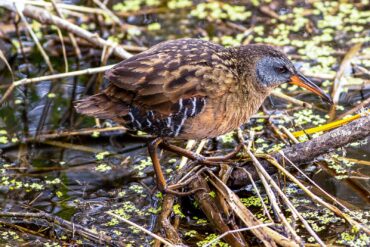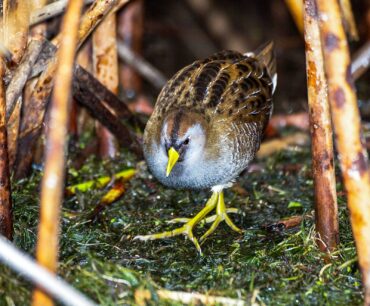
There is no shortage of variety in the world of birds. There are remarkable differences between a heron and a hummingbird or a swan and a swallow. Also, there are places where humans would never dwell, but birds consider appealing.
Freshwater marsh habitat can host a surprising diversity of birds. Herons and raptors hunt for fish and amphibians, songbirds such as marsh wrens and red-winged blackbirds nest in tall vegetation, and waterfowl consider it paradise.
A marsh full of reeds and cattails is also a refuge for those who prefer to make their living in secret. The shallow water and mud in between the emergent vegetation provide secret passages unseen to potential predators and humans. An unsuspecting individual may be unaware of the presence of such stealthy birds a short distance away.
Two similar species of small wading birds are reasonably common in the appropriate habitat in Washington but are seldom observed. Here in West Sound, the Virginia rail and sora may make rare appearances in the open. They may also frustrate seasoned birders who search endlessly for these elusive species and continuously come up empty.
Both the Virginia rail and sora are fairly common species of freshwater marsh such as the Clear Creek Trail in Silverdale. They’re also found in brackish marsh (where freshwater meets saltwater) such as Theler Wetlands in Belfair. You’re most likely to see these furtive birds while they forage by the emergent vegetation on the edge of a pond, but they seldom offer more than a fleeting glimpse.

More often heard than seen, both species are most easily detected when vocalizing during the breeding season. The Virginia rail grunts and calls with a series of rapid notes. The sora utilizes a two-note call and its trademark descending whinny.
Resembling a medium-sized shorebird, the Virginia rail has mostly reddish tones with a gray face. Built for its lifestyle, it has long legs and toes for walking on mud and flexible vertebrae on a laterally compressed body for passing through narrow openings. Strong leg muscles encourage a preference for ground travel, so flights are usually short, except during migration. It uses a long, decurved bill to probe in mud for invertebrates. Firm forehead feathers don’t wear out while pushing past stiff stalks.
The Virginia rail breeds across the northern United States and portions of southern Canada. Migratory birds mostly winter along coastal wetlands of the Atlantic Coast and the Gulf of Mexico, while some go inland to southern Arizona and Mexico. Pockets of year-round populations inhabit the East Coast, West Coast and select locations of the West, including the Puget Sound region.
Washington’s other member of the rail family is the equally elusive sora. A common summer resident in Eastern Washington, the sora is uncommon in Western Washington. With a similar build to the Virginia rail, the sora is most easily differentiated from its cousin by a short, yellow bill that almost looks like a candy corn stuck to its black face mask. The colorful sora has mostly gray underparts and reddish upperparts with striking black-and-white streaking throughout.
You can typically find the sora near the Virginia rail, though it encompasses a broader range. Breeding farther north than its cousin, the sora spends summers across most of Canada and the United States, including West Sound. Its wintering range extends from the southern coast to northwest South America. Small pockets stay on breeding grounds year-round, generally in portions of the American Southwest.
Despite inhabiting the same environment, the Virginia rail and sora choose different entrées from the marsh menu. The Virginia rail primarily eats insects, arachnids, snails, crayfish, small fish and frogs. In winter, it supplements its diet with plant seeds. The sora uses its long toes to rake floating vegetation for seeds, which it consumes year-round. It supplements its diet with aquatic insects it gleans from the water’s surface.
Both species have similar nesting habits. Dense cattails and bulrushes provide choice locations for nest baskets of woven plant material, often built on floating mats of vegetation or low on cattail stalks.
Outside of the breeding season, the two species live solitary lives as they dart about the marsh, sometimes swimming short distances and scurrying effortlessly along mud and floating vegetation. Juveniles leave the nest within a week of hatching but are closely watched by the parents.
Numbers are stable, as both the Virginia rail and sora are relatively common. But their secretive nature makes it difficult to accurately survey them. Since they are marsh specialists, habitat loss is the greatest threat to their survival.
For birders, nothing is more satisfying than finding an elusive species. The Virginia rail and sora are prized additions to anyone’s bird list. These unique species remind us why marsh habitat is worth protecting.



























